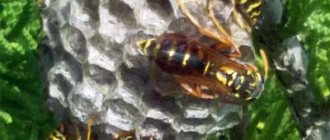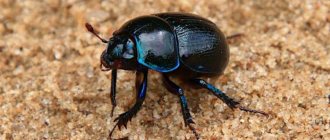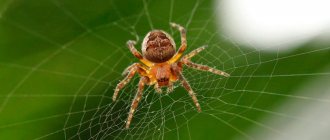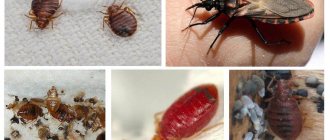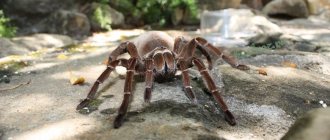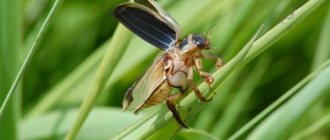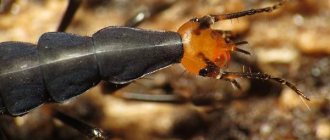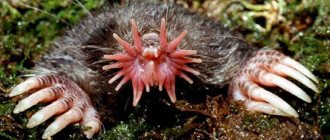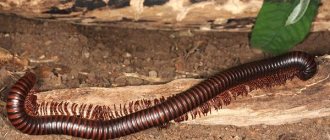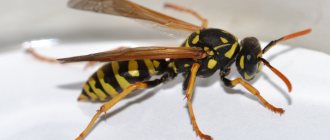Where do hornets live?
Many people are interested in how hornets hibernate - these large wasp-like insects that bite so painfully.
For most people, hornets cause panic, and sometimes even horror. Even from school, we learn that hornet venom that enters the human body causes a severe allergic reaction, and a large amount of it can lead to anaphylactic shock. It is the fear of death that makes people destroy insects. In this publication we will talk about the way of life of hornets.
How dangerous are hornets to humans?
Hornets can pose a danger to people in some cases. To protect themselves, the hornets gather very quickly; for this, the individual releases a special substance - an alarm signal. Other individuals can react to it and fly to the aid of a comrade and attack the offender en masse. Therefore, you should not touch the hornet in vain.
The mortality rate from hornet stings is very low, but the risk is still present. In addition, each subsequent sting will be worse tolerated by the body, because immunity to the poison is not developed, but on the contrary, the negative reaction intensifies.
Let's get to know each other better
The classification of insects states that there is a separate genus of hornets, which belongs to the family of true wasps. Wasps that are familiar to us belong to the same family. They are called paper wasps. Thus, hornets are their close relatives. Therefore, they are very similar to them in appearance, as well as in their method of nutrition, reproduction and general lifestyle.
However, hornets have their own characteristics, both biological and behavioral. We will focus on them in our article.
Hornets are social insects that live in large families, also called colonies. By the beginning of September, their numbers can range from 400 to 800 individuals.
The family consists of one queen, several females, males and workers. Only the queen of the colony lays eggs. Therefore, to prevent mating and laying eggs by other females of the family, the queen emits a special odor. As a result, females lay unfertilized eggs, from which only drones are born.
Hornets are larger than wasps. The size of the uterus can reach 25-35 millimeters, and males and workers 22-30 millimeters. The front half of the chest and the head of the hornet are yellow. There are rings on the body - the first two are dark brown with yellow stripes, and the rest are yellow with the presence of brown spots. The body of the insect is covered with villi.
On the top of the head are three large compound eyes of a reddish-orange color. The oral apparatus of hornets has the shape of a gnawing type, but is only equipped with very strong mandibles. Females and workers have a sting, which is a modified ovipositor.
What are the different types of insects?
There are 23 species of hornets in the world, which in turn are divided into subspecies.
The most common types include:
- European, which is distinguished by red pigmentation on the head and large body. They are found throughout the Russian Federation, including Siberia. Very common in the Primorsky Territory. Also, often found in the Moscow region.
- Eastern - the body is brown in color. They live in Asia, Africa, Europe (including the vast expanses of Russia).
- Filipino - a bite leads to the death of a person. Insects are common in the Philippines.
You should know that in some countries hornets are protected by the state. For example, in Germany, a fine of 50 thousand euros will be imposed for destroying a hornet nest.
What they look like
Entomologists know very well what hornets look like and will not confuse them with other insects.
The large wasp differs from other members of the family in the following characteristics:
- The head is larger, with a wide upper part. These Hymenoptera have 2 compound eyes and 3 simple ocelli.
- The head color varies between black, yellowish, orange or reddish brown interspersed with yellow spots. There are black-brown antennae on the head. The number of segments differs in females and males. The color of the jaw is black, brown or orange-yellow.
- The abdomen is rounded. In the area of its articulation with the chest, a beautiful thin waist line is visualized. In its color palette it resembles the common wasp, but the stripes are not so pronounced.
- At the end of the abdomen of working females and the uterus there is an ovipositor, which is a sting. If the insect manages to live calmly, then the sting is retracted into the abdomen and is not visualized. At its base there is a poisonous gland filled with a toxic substance. The sting is straight, smooth and has no jagged edges. A hornet can live with a used sting for a long time.
- Set of lower limbs - 3 pairs of legs, black, brown or yellow. Each limb includes a coxa, an acetabular ring, a proximal part, a tibia ending in a spur, and a tarsus.
The insect's wings are transparent with large cells . They are presented in 2 pairs: the front ones are large, the rear ones are small. While the hornet manages to live quietly, its front wings are connected together along the back.
During flight, the leading edge of the small wings is attached to the trailing edge of the large ones using special hooks. As a result, both right and both left wings create one aircraft.
What do they eat?
Nature created hornets as predators. Therefore, they mainly feed on other insects. They not only eat live insects, but can also feast on the carcass of a recently deceased animal. Hornets eat only those bodies in which the process of putrefaction has not yet begun. The diet of striped insects is supplemented by sweet fruits and berries, which are already beginning to decompose.
They love overripe fruits: plums, apricots, peaches, strawberries, raspberries, blackberries and grapes. With pleasure they feast on all beekeeping products. A squad of several hornets is capable of destroying an entire swarm of bees. They eat and take back to their nest everything they find in an empty hive. Thus, they can be safely classified as omnivores.
Wasps
In scientific Latin, the hornet is an insect designated as Vespa - "wasp". Vespula – denotes a common genus of wasps (literally translated as “wasp”). In science there is a clear classification of this type of insect, but in real life there is confusion when distinguishing between large hornets and other representatives. True wasps are smaller and have a bright yellow and black coloration, while the hornet is a darker-colored insect.
There are large wasps called hornets. A special place among them is occupied by the spotted Dolichovespula Maculata. She lives in North America. In English it is called a Bald-faced hornet, just like real hornets. It has black color and ivory stripes. Most likely, wasps are called hornets because of their habit of creating above-ground nests. There is also the Australian hornet Abispa Ephippium, a species of solitary wasp.
Where do the winged "pirates" live?
Hornets are called “pirates” because of their habits. They very brazenly commit robberies and thefts from other insects, in particular bees. At the same time, they act bravely and wisely. When getting their food, they use only their powerful jaws. The sting with poison is used only for self-defense from large animals and people.
Where do hornets live? They choose a variety of biotopes to live in, which are not necessarily associated with human habitation and agricultural land. Striped insects settle close to people due to the abundance of food.
- There are always many insects living around a person’s home.
- Human food supplies serve as food for hornets.
A hornet can easily fly into the kitchen and profit from something. For example, to separate a small piece of meat from a piece from which the housewife plans to cook something. Berries and fruits grow in gardens and plots. Some people keep bees. In addition, it is convenient to build nests on human structures.
What is a hornets nest?
Hornets, called Vespa in Latin, are social insects. They live in families, creating a cozy nest for themselves. The nest is always laid by the queen, who builds the first combs. After this, the remaining individuals of the family join in the construction.
The home of these large wasps is built from young bark, which they gnaw from the tops of tree branches.
Chewing it with their powerful jaws to a pulp, similar in appearance to paper softened in water, they begin to form honeycombs from this “building material”, then constructing a thick protective wall around them. Such a dwelling is built layer by layer, from top to bottom.
The hive that Vespa builds for itself is a structure with the following approximate parameters:
- about 40 cm wide;
- height 70 cm;
- wall thickness 8 cm.
The nest itself is multi-tiered, with an intricate system of labyrinths and honeycombs in which the larvae are located. It is to feed these larvae, which are incredibly carnivorous and voracious, that hornets need to hunt other insects - flies and mosquitoes, grasshoppers and spiders, locusts and bees. Adults are not averse to eating sweet plant food, in the form of flower nectar, the pulp of overripe fruits, aphid secretions and especially honey.
This is interesting:
Most often in wildlife, hornets make nests in tree hollows or earthen holes, but within human habitation, any secluded place on the estate, protected from wind and drafts, rain and sunlight, can become a construction site.
- attics of residential buildings or outbuildings;
- chimneys;
- space under the roof of verandas, sheds and summer kitchens;
- outdoor toilets;
- voids in concrete pillars;
- old cars that have not been used for a long time.
The size of the nest always depends on the number of larvae and the number of hornets themselves. Externally, it has a light gray color and a structure similar to corrugated paper or cardboard. If such a nest is located near the entrance to the room, it is better not to enter it until you get rid of the unpleasant and dangerous neighbors.
The home built by Vespa has only been in existence for one year. If the queen remains to spend the winter in it, then next spring she will begin to build a completely new home for her family.
Lifestyle
The rules for the existence of hornets in nature are very similar to those of bees and ants.
In order to survive during the cold winter and give birth to offspring every year, insects have to sacrifice someone and something. They sacrifice males, who die soon after mating. This way resources are not wasted on already “useless” individuals. After all, in the hornet family, the females are the main ones. Therefore, they must prepare well for hibernation, survive it, and in the spring become the founder of a new colony. The uterus needs a large amount of protein to produce eggs and develop ovaries. In order to successfully overwinter, it eats very richly and accumulates a fat body.
How social wasps overwinter
Many people do not even suspect that wasps are divided into social and solitary individuals. Just one name is enough to understand the difference between these two types of wasps. Social individuals live in entire families. In this they even resemble people. Single individuals live separately from each other. It is important to note that this division is present in many insect species. Typically, wasps that lead a solitary lifestyle first mate and then lead an extremely solitary lifestyle.
Females build nests and then leave a small supply of food there for the larva. Usually small spiders and other insects act as food. Once the cell is filled, the female seals it. Then the larva eats the food prepared by the mother and develops right inside the cell. Then the young individuals scatter around the area and look for where they can build their own nest. Despite the fact that single individuals live separately from each other, they also reproduce. By the way, in wasps, only the uterus can continue the birth.
So how do wasps overwinter in nature? Overwintering in nature can be very difficult. Wasps do not feel their best in the autumn-winter period. The fact is that hibernation is the lot of only young and fertilized wasps. Males die immediately after fertilization. Sometimes, after the onset of cold weather, the entire wasp family dies, abandoned by young males and females. The death of a family means the death of the queen and worker wasps, who also lived in the old nest. The fact is that working individuals live only 4 weeks. The uterus can live as long as 10 months. Where do young wasps spend the winter? They usually look for a secluded place where they can spend the winter. Only after a warm place is found do the insects fall asleep. They can wake up only in the spring, when the air temperature becomes higher. Female social wasp species can only be fertilized by a male once. After wintering ends, they begin to look for a place for a new nest.
Where do hornets winter and their diet in winter?
Hornets are insects similar to ordinary wasps, but differ in larger sizes. These insects are considered dangerous because they bite very painfully, and if a person has a tendency to allergies, then after such a bite it is likely to develop Quincke's edema or anaphylactic shock.
Physiologically, hornets are designed in such a way that they cannot regulate their body temperature, which means that with the onset of cold weather they must die. But nevertheless, they spend the winter somewhere and appear in the spring, begin active work in building nests, breeding offspring, etc. In this regard, it is very interesting where hornets winter, how they manage to protect themselves from cold and dampness.
Hornets are close relatives of common wasps; they have a similar body structure, feeding and life characteristics, reproduction and distribution. But still, in some ways, hornets differ from their relatives, for example, wasps always use their sting, both for the purpose of self-defense and when obtaining food. But hornets use their poison solely to protect themselves, and they kill insects for food with their jaws.
Tips on how to get rid of hornets
Hornets are dangerous to humans, but they also eat many insect pests, which benefit the garden. Therefore, it is recommended to destroy their nests only as a last resort, when these insects have settled very close to the house or near a bee apiary.
You can get rid of these insects using various methods listed below:
- If a hornet has flown into an apartment, you should not drive it out with your hands or try to slam it with a towel, as the insect will perceive these actions as a threat and will attack. It is better to wait until it sits on a flat surface and cover it with a glass jar. Then the neck of the container must be carefully closed with a lid and taken outside so that the individual flies out of the jar.
- To scare hornets away from your garden plot, you can hang a pod of red hot pepper near their nest.
- A decoction based on boric acid will help destroy a small number of insects . To 200 ml of water you need to add crushed fly agaric mushrooms (2-3 pcs.) and 1 tbsp. l. boric acid, then boil the mixture on the stove for a few minutes. Cool the resulting poison and pour it into small containers, adding a little honey to it as bait.
- You can install traps made from plastic bottles . The top of the bottle must be cut off, turned over and inserted neck down into the remaining lower half of the container. Pour honey or jam into the bottom of the trap as bait so that insects fly inside through the neck and cannot get out.
- Hornets are repelled by the pungent aroma of some plants. To drive away insects, you need to plant geranium, lemon balm or mint on the site.
- If you fill a bucket with water and place it on a stepladder so that the nest is at least partially submerged in water, then all members of the family will get wet and die.
- You can pour a large amount of boiling water over the nest so that it gets on all parts of the structure. When exposed to high temperature water, all individuals will die.
- To exterminate the entire family , you can seal the entire surface of the nest and its main opening using foam. It will block the insects' access to oxygen and light, resulting in all individuals suffocating. After this, the nest can be removed and destroyed.
- You can pour gasoline on the nest and then set it on fire. Fire will completely destroy the hornets, but this method cannot be used if there are flammable objects nearby or the nest is located under the roof of a house.
- If the insect nest is in a hard-to-reach place, then you can light a special wasp smoke bomb . During smoldering, it releases poisonous permethrin, which kills insects.
- To drive hornets out of your area, you can install an ultrasonic insect repeller . It produces sound waves that are not perceived by the human ear, but have a negative effect on hornets.
- To exterminate these insects, there are store-bought chemical insecticides (Dichlorvos, Karbofos, Raptor, etc.). This product should be sprayed onto the inside of a plastic bag, and then put on the socket and secured with tape or thread.
Important! To avoid bites, all actions to get rid of insects should be carried out at night. In this case, it is necessary to use protective gloves, thick clothing and a face net.
Hornets are very interesting insects that have a complex caste hierarchy. Due to their large size and the presence of poisonous glands, they can pose a danger to other insects and humans. The detailed description of hornets presented in this article will help to better study the lifestyle of these insects and effectively get rid of them if there is a threat.
A little about hornets
Hornets are very large wasps, up to 5.5 cm long. They live in colonies of up to 400 individuals. They build horizontally located nests, which are honeycombs in several rows of five hundred cells each.
Giant wasps make their homes in warm places that are protected from winds and rain. They often prefer proximity to humans, as they like to eat the remains of human food. They also eat other smaller insects, rotting fruits, and drink plant juice.
The nest and its search
To make their hive, hornets use young tree bark. To build, they chew it, moistening it with saliva, which makes it soft and sticky. Then they build a nest in the shape of a ball, cocoon or cone of brown or gray color, the dimensions of which can reach up to 70 cm, as seen in the photo of a hornet nest. Many adult workers are doing this at once, the noise from moving and chewing bark can be heard several meters from the hive.
Construction is carried out in tiers, usually from top to bottom. Inside there are honeycombs of several floors and numerous passages, similar to the contents of a bee hive. The total number of plates with honeycombs sometimes reaches 500.
It is difficult to calculate how many hornets are in a nest at a certain time, since the number of residents in a colony depends on favorable conditions and nutrition, and on the stage of development. The queen moves regularly, laying eggs, and worker insects take them to the honeycombs and feed them, watching the development of the larvae and their transformation into adults. On average, a hive can have 300-400 inhabitants.
The location of the nest with hornets can be different; their selection criterion is to find a secluded place where there is no wind or draft:
- utility or household premises;
- attic or roof space;
- a secluded place on a balcony or loggia;
- in the cracks of the building's skin;
- in the branches of a bush or tree;
- inside a tree stump or hollow;
- abandoned animal holes in the ground.
To detect such a nest, the easiest way is to follow the flight of insects by placing some kind of food bait, which they will drag piece by piece into their colony.
Wintering of insects
The peculiarity of hornets is that they lack thermoregulation. When cold weather sets in, they need to hide safely and fall into torpor. Otherwise, the insects die.
Making a nest for the winter
Insects build their homes from wood ground up by their jaws and mixed with saliva. To protect against temperature changes and other negative factors, the honeycombs themselves, in which the larvae develop, are wrapped in a wood mixture reminiscent of a paper cocoon.
The nest often resembles a pear or ball in shape. It is distinguished by amazing symmetry and precision of shape.
The larger the diameter of the wasp house, the more individuals live in it. The ability to build nests is passed on to each generation genetically. A fertilized female, the queen, wakes up after hibernation and chooses a place for the future residence of the entire swarm.
There she attaches the base and makes the first few (3-5) cells. Eggs are laid in them, the first larvae develop, from which worker representatives of the genus emerge. They also complete the construction of the hive afterwards. Nests are used only in the warm season for raising larvae in honeycombs.
Wasps settle in secluded places:
- hollows;
- animal burrows;
- under the roofs of houses;
- in the cracks of trunks;
- in rock crevices.
Wasps leave the house for the winter. Those individuals that are going to spend the winter do not specially prepare their hibernation site in any way. It is simply selected so that no one discovers the insect and accidentally destroys it. You should not be afraid that the wasp will decide to wait out the frosts in a warm human house.
When and how do they hibernate?
In mid-autumn, the hornets leave the nest and begin active mating. With the arrival of frost, they cannot maintain their metabolism and in order to survive, they hibernate. Only fertilized female hornets settle down for the winter.
The queen, drones and workers simply die. The fluid in the insect's body is represented by glycerol. Thanks to this, it does not turn into a piece of ice at sub-zero temperatures and is able to warm up and continue to function with the arrival of spring.
Where do they spend the winter?
Females always settle down for the winter in a cold place. These can be unheated abandoned premises, recesses between bricks in the outer part of the walls of residential buildings, hollows, cracks in the bark, holes, places under large stones.
Hornets vs honey bees
It will not be a revelation to anyone that these bright and huge insects have long been labeled “killers”; this statement, of course, applies to insects.
But this label was assigned not entirely fairly, even, one might say, incorrectly. They do kill other insects, but this is a kind of hunting and not for fun, but for the sake of feeding their offspring. Nature has decreed that in order to continue the population, they need to regularly go hunting and get new food to bring to the nest and feed the offspring. It is not their fault that their diet consists of other insects.
And the point is not at all about bees; they, like other insects, simply serve as food for their family. It is worth saying that they even hunt small frogs, since nature has awarded them with strong and large jaws.
Having figured out why they kill insects, you can understand that they received the title of killers completely undeservedly, because in this case this title can be assigned to ants. After all, goosebumps also constantly bring home bugs, larvae, caterpillars and other insects, but no one labels them “killers.” Perhaps the reason is that the struggle of a hornet is much more spectacular than that of an ant.
It is worth saying a few words about why hornets choose beehives. In fact, in this matter everything is very clear and simple - this is an ideal feeding place. A large number of individuals gather in this place and they are easy to catch, which reduces the time spent searching for food.
It is also a valuable nutritious product, which is important. Well, one more important point: there is always the opportunity to enjoy honey, and the diet of adults consists mainly of sweet foods
How one can understand the choice of bees as a hunting object is completely understandable. The presence of at least one hive in the hornets’ habitat provides the entire colony with adequate nutrition, and they obtain food without much effort.
You should not think that they specialize in killing bees; they hunt completely different insects, but they will not refuse such healthy food, especially if the hive is nearby.
